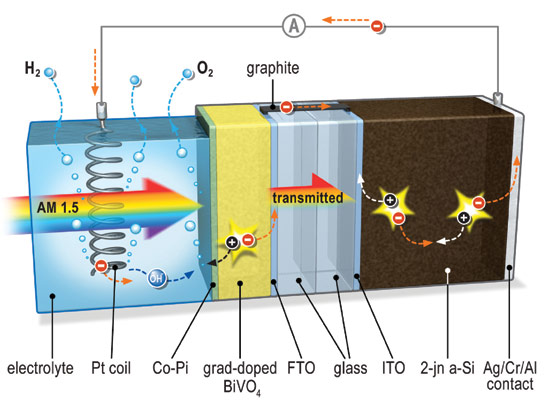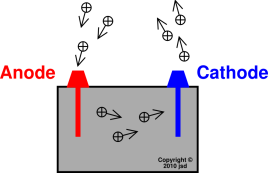Solar Energy Leads To Breakthrough In Hydrogen Production
This article is more than 2 years old
 Scientists at the Helmholtz Zentrum Berlin Institute in Germany, and Delft University of Technology in the Netherlands, have made an important breakthrough in the conversion and storage of solar energy in the form of hydrogen. The scientists used artificial photosynthesis to store solar energy as hydrogen.
Scientists at the Helmholtz Zentrum Berlin Institute in Germany, and Delft University of Technology in the Netherlands, have made an important breakthrough in the conversion and storage of solar energy in the form of hydrogen. The scientists used artificial photosynthesis to store solar energy as hydrogen.
To do this, they used a photoanode–an electrode that passes electrical current into a device or circuit–made of metal oxide (bismuth vanadate, or BiVO4, in case you’re keeping track). They added tungsten atoms to the oxide, perhaps because it’s one of the coolest elements on the periodic table—its symbol is, rather inexplicably, “W”—or maybe because it helps with conductivity. One or the other. Then, they sprayed the photoanode onto a thin, silicon-based film cell coated with cobalt phosphate.
When light hits, it builds electrical potential, and the photoanode catalyzes oxygen formation. Researchers “don’t really understand quite yet why bismuth vanadate works so much better than other metal oxides,” but they do know that it “sets a new record for metal oxides,” because over 80 percent of its photons contribute to the current. The cobalt phosphate then conducts to the silicon solar cell, which doesn’t corrode because only the layer of metal oxide touches the electrolyte. Then, a cathode, the opposite of an anode, comprised of a platinum spiral forms the hydrogen.
 This may sound like a game of mad scientist, or a bunch of chemistry students let loose in a lab, but there’s some major stuff going on here. When scientists combined the stable metal oxide with the silicon-based solar cell, they produced a “cost-effective, highly stable, and highly efficient solar fuel device.” In other words, they used sunlight to split water into hydrogen and oxygen, which then allows them to store the hydrogen for use as energy.
This may sound like a game of mad scientist, or a bunch of chemistry students let loose in a lab, but there’s some major stuff going on here. When scientists combined the stable metal oxide with the silicon-based solar cell, they produced a “cost-effective, highly stable, and highly efficient solar fuel device.” In other words, they used sunlight to split water into hydrogen and oxygen, which then allows them to store the hydrogen for use as energy.
And what’s so great about hydrogen energy? For one thing, it’s not a pollutant. The only byproducts from the process of extracting energy from hydrogen molecules are water and heat. The hydrogen isolated and stored by artificial photosynthesis can be used as methane, or can be used in a fuel cell to generate electricity. An experiment in Germany designed to demonstrate the ability to convert and use solar energy as hydrogen power harnessed and stored 3-kilowatt hours of hydrogen energy from only one hour of sunshine. Storing bigger quantities of hydrogen power could allow for its use as energy for long stretches of time, rain or shine.
The breakthrough “combines the best of both worlds” in its production of a stable, inexpensive, and efficient means of harnessing solar fuel. While using hydrogen fuel apparently hasn’t saved NASA enough money, perhaps hydrogen cars have a chance after all–Toyota’s set to follow up the Prius with an “affordable” mass-market hydrogen car in 2015, and Hyundai is working on a similar, though pricier, model.











